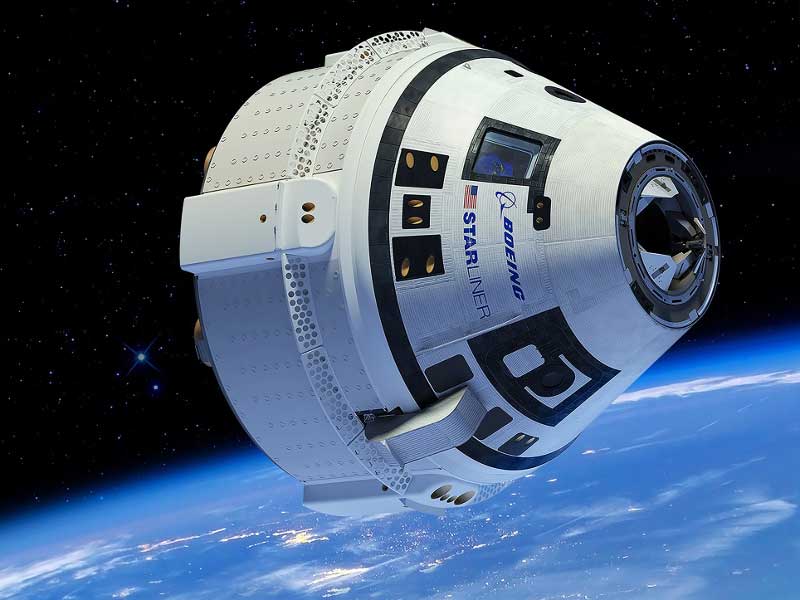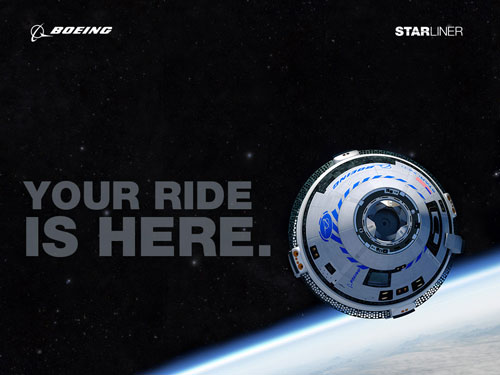Boeing CST-100 Starliner
This crew carrying capsule has been developed by the American aerospace giant Boeing. It is designed to be used primarily as a means of transporting astronauts from Earth to the International Space Station (ISS) and possibly to other future Earth orbiting stations such as those proposed by private operators Bigelow Aerospace.
It is designed to be, in practice, a very flexible space ferry, capable of being launched on at least four different rockets, and also able to dock with a wide variety of orbiting stations. It will be able to carry up to seven crew members into low earth orbit (LEO). Excitingly for potential space tourists, one of these seats is reserved for commercial passengers, with the prospect of a trip to LEO and possibly the ISS for wealthy adventurers.
NASA is also developing an alternative space capsule called Orion, in conjunction with American aerospace manufacturers Lockheed Martin and the European Airbus company, but the two capsules are built for different purposes and so are not really rivals. While the Starliner is focused on Earth orbiting missions, Orion is intended for use with NASA’s SLS rocket system on longer distance missions to the Moon and Mars.

History and Development of the CST-100 Starliner
Plans for this commercial capsule design were first announced in 2010. The Boeing CST-100 was proposed as the means of ferrying passengers to Bigelow’s new space hotel, which he envisaged orbiting the earth in the foreseeable future. CST is an acronym for Crew Space Transportation, while the 100 is apparently merely a random attractive number thought up by the company’s media department.
Funding for its production was dependent upon financial support from NASA. Here Boeing were pushing on a door which was at least partly ajar. NASA required a replacement for the Space Shuttle, which was already being slated for retirement, and flew its final missions in 2011. The only alternative means of getting its astronauts to the ISS was via Russia’s Soyuz, and this remains the case at the time of writing. The current agreement is due to end in the spring of 2020, having already been extended several times.
Boeing also valued the potential of Bigelow’s plans in offering the potential of a second destination for their capsule.
Good news arrived in the form of a $92 million contract from NASA to continue development of the Starliner. This came in 2011 just as the space shuttle Atlantis took its last flight and the programme came to an end.
A further boost came in 2014 when, together with SpaceX’s Dragon capsule, Boeing’s Starliner was awarded the contract to provide crewed missions to take NASA astronauts to the ISS. This agreement also made provision for a seat to be provided to space tourists, showing that this possibility was intended to be offered at a very early stage of the Starliner’s development.
It wasn’t all good news though. Boeing subsequently failed in its attempt to win a contract to supply cargo to the ISS, with SpaceX’s Dragon spacecraft winning this lucrative deal. SpaceX have already run several successful supply missions to the ISS, while Boeing’s Starliner will continue to be focused on delivering crew carrying flights as part of its shared contract with SpaceX.
Testing continues on the capsule. A variety of setbacks have resulted in delays to the original production timetable. However, a variety of tests have been successfully completed, including those for its propulsion systems, environmental compatibility and parachute landing equipment. An abort test, designed to safely carry the capsule to safety in the event of a rocket launch malfunction has also been successfully completed.
However, a further setback came in July 2018, when a propellant leak was detected from faulty valves during testing on the ground. This has resulted in further delays.
The Starliner’s first uncrewed trip to the ISS is now scheduled for August 2019. It will be launched into space on a United Launch Alliance (ULA) Atlas V rocket. If successful, the first crewed mission is expected to follow a few months later.
The three astronauts who will be taking their places on the Starliner’s inaugural crewed mission to the ISS have been announced, and the Atlas V rocket for the launch has already been delivered to Cape Canaveral in preparation for the big day.
Construction and Characteristics of the Boeing Starliner
The Starliner capsule is designed to carry up to seven astronauts (or passengers) into orbit. It can also carry cargo or a combination of both. The capsule is 5 metres long (16.5 ft), including its service module. It has a diameter of 4.5 metres (15 ft) and a total volume of 11 cubic metres (390 ft3).
It is also designed to be able to be launched by a variety of different rockets, which makes it a very flexible capsule indeed. It is compatible with The Atlas V, Delta IV and SpaceX’s Falcon 9 rockets, and will also be capable of being launched by the new ULA Vulcan rocket.
The Starliner is designed to fly entirely autonomously, which greatly reduces the amount of training required for its crew. There will always be a qualified pilot on board of course, in case of emergency or mishap. Back-up manual controls are available at all times, much like the auto-pilot / manual control systems on modern airliners. An abort system for the capsule has already been successfully tested. This will carry the crew to safety should a malfunction occur at or shortly after launch. When used to supply the ISS, again the Starliner is designed to dock autonomously, so no human input should be required.
One major difference between this capsule and all the previous American designs is that the Starliner is designed to return to Earth on land, rather than in the ocean. This is the method preferred by Russia’s Soyuz spacecraft. The Starliner will use conventional parachutes and a complex set of airbags to land safely back on dry land.
Returning a capsule on land does have several advantages. It is easier (and cheaper) to recover the crew from land rather than at sea – they are easier to find and rough seas can make things even more difficult for the recovery ship. Things are also more uncomfortable for the capsule crew, not to mention the risk of drowning.
Another major advantage of a hard landing is that sea water is extremely damaging to the capsule. Salt water is corrosive and does not mix well with complex electronics and computer systems. By returning to dry land, it is expected that the Starliner will be capable of being re-used up to ten times before retirement.
The Future for The Starliner
The future for Boeing’s Starliner certainly looks bright. Its first uncrewed test flight is due in August 2019, when an Atlas V rocket will send it on its way to an autonomous docking with the ISS. A crewed test flight will follow shortly afterwards.
Should these be successful, NASA has already signed up the Starliner for six crewed missions to the ISS. During these, the capsule will carry up to four astronauts to the space station on a normal crew rotation. It can then remain docked in space for up to six months if necessary, before returning to Earth.
NASA has already reserved at least one seat on the Starliner for commercial passengers, so it is likely that the first space tourists could arrive at the ISS soon, perhaps as early as 2020. Further into the future, remember that Bigelow Aerospace has been closely involved with the development of the Starliner, and it is intended that it too will use the capsule to ferry passengers to its proposed space hotel.
In the short term, the cost of a ticket to space is likely to be enormous: billionaires only need apply. Over the longer term though, prices are likely to fall substantially, and quickly. Rival space operators Blue Origin, Space X, and Virgin are all likely to be competing to send tourists into space over the next few years. And with a potential six spare seats on board (plus one for the pilot), it is likely that Boeing too will soon be able to offer tourist exclusive flights into orbit. Better start saving…

